International Business: Cambodia's Competitive Advantage Report
VerifiedAdded on 2021/05/31
|7
|1144
|66
Report
AI Summary
This report analyzes the international business environment of Cambodia, focusing on its national resources and factor endowments that create a competitive advantage. It examines the existing levels of Foreign Direct Investment (FDI) in the country, highlighting key sectors like agriculture, textiles, and tourism. The report details Cambodia's economic growth, its attractiveness for FDI, and the government's efforts to improve infrastructure and regulatory settings. It assesses the potential for investment in various sectors and provides recommendations for attracting more foreign investment, emphasizing the need for infrastructural improvements and relaxed regulations. The report concludes by summarizing the key findings and suggesting strategies to capitalize on global economic opportunities.
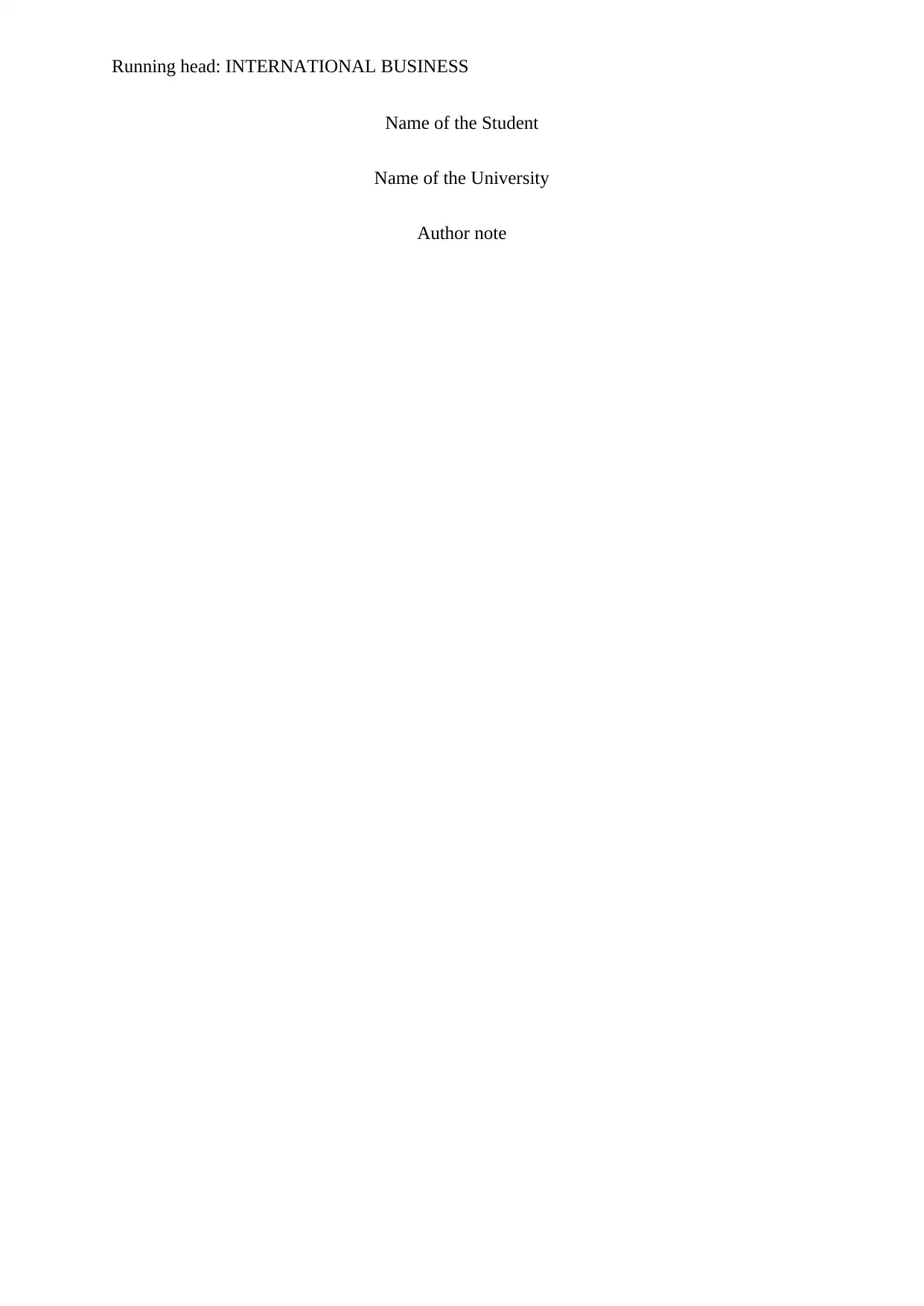
Running head: INTERNATIONAL BUSINESS
Name of the Student
Name of the University
Author note
Name of the Student
Name of the University
Author note
Paraphrase This Document
Need a fresh take? Get an instant paraphrase of this document with our AI Paraphraser
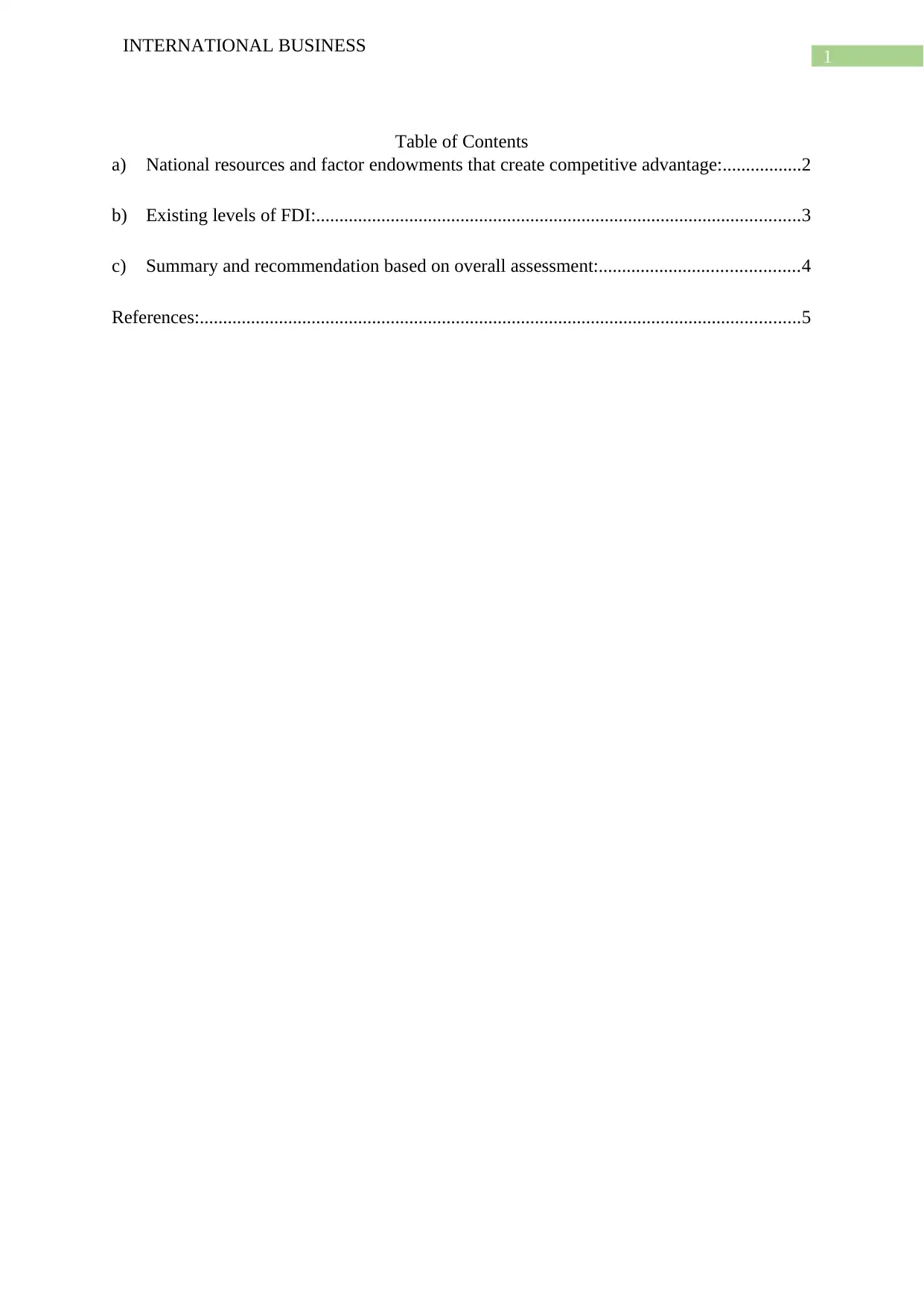
1
INTERNATIONAL BUSINESS
Table of Contents
a) National resources and factor endowments that create competitive advantage:.................2
b) Existing levels of FDI:........................................................................................................3
c) Summary and recommendation based on overall assessment:...........................................4
References:.................................................................................................................................5
INTERNATIONAL BUSINESS
Table of Contents
a) National resources and factor endowments that create competitive advantage:.................2
b) Existing levels of FDI:........................................................................................................3
c) Summary and recommendation based on overall assessment:...........................................4
References:.................................................................................................................................5
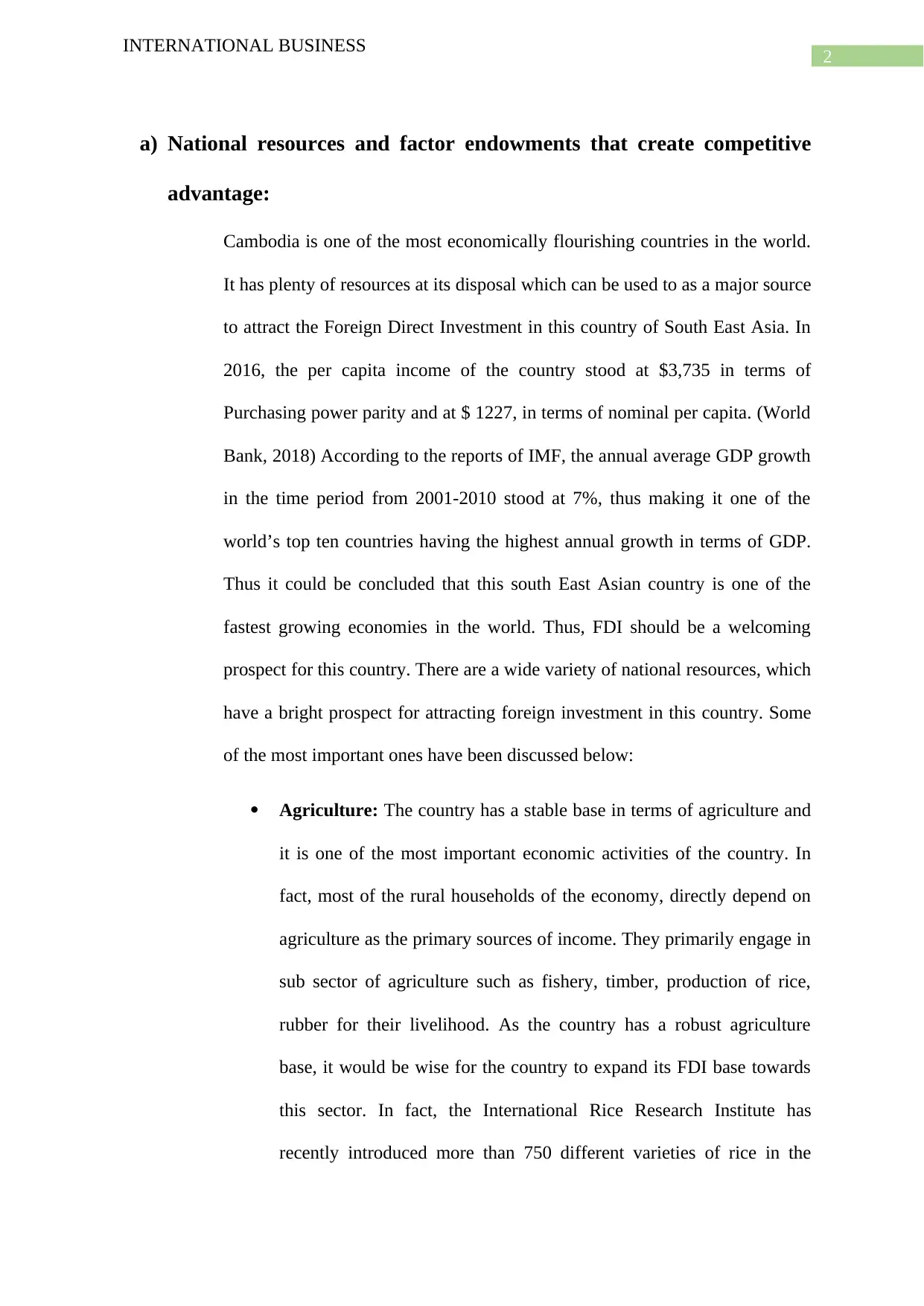
2
INTERNATIONAL BUSINESS
a) National resources and factor endowments that create competitive
advantage:
Cambodia is one of the most economically flourishing countries in the world.
It has plenty of resources at its disposal which can be used to as a major source
to attract the Foreign Direct Investment in this country of South East Asia. In
2016, the per capita income of the country stood at $3,735 in terms of
Purchasing power parity and at $ 1227, in terms of nominal per capita. (World
Bank, 2018) According to the reports of IMF, the annual average GDP growth
in the time period from 2001-2010 stood at 7%, thus making it one of the
world’s top ten countries having the highest annual growth in terms of GDP.
Thus it could be concluded that this south East Asian country is one of the
fastest growing economies in the world. Thus, FDI should be a welcoming
prospect for this country. There are a wide variety of national resources, which
have a bright prospect for attracting foreign investment in this country. Some
of the most important ones have been discussed below:
Agriculture: The country has a stable base in terms of agriculture and
it is one of the most important economic activities of the country. In
fact, most of the rural households of the economy, directly depend on
agriculture as the primary sources of income. They primarily engage in
sub sector of agriculture such as fishery, timber, production of rice,
rubber for their livelihood. As the country has a robust agriculture
base, it would be wise for the country to expand its FDI base towards
this sector. In fact, the International Rice Research Institute has
recently introduced more than 750 different varieties of rice in the
INTERNATIONAL BUSINESS
a) National resources and factor endowments that create competitive
advantage:
Cambodia is one of the most economically flourishing countries in the world.
It has plenty of resources at its disposal which can be used to as a major source
to attract the Foreign Direct Investment in this country of South East Asia. In
2016, the per capita income of the country stood at $3,735 in terms of
Purchasing power parity and at $ 1227, in terms of nominal per capita. (World
Bank, 2018) According to the reports of IMF, the annual average GDP growth
in the time period from 2001-2010 stood at 7%, thus making it one of the
world’s top ten countries having the highest annual growth in terms of GDP.
Thus it could be concluded that this south East Asian country is one of the
fastest growing economies in the world. Thus, FDI should be a welcoming
prospect for this country. There are a wide variety of national resources, which
have a bright prospect for attracting foreign investment in this country. Some
of the most important ones have been discussed below:
Agriculture: The country has a stable base in terms of agriculture and
it is one of the most important economic activities of the country. In
fact, most of the rural households of the economy, directly depend on
agriculture as the primary sources of income. They primarily engage in
sub sector of agriculture such as fishery, timber, production of rice,
rubber for their livelihood. As the country has a robust agriculture
base, it would be wise for the country to expand its FDI base towards
this sector. In fact, the International Rice Research Institute has
recently introduced more than 750 different varieties of rice in the
⊘ This is a preview!⊘
Do you want full access?
Subscribe today to unlock all pages.

Trusted by 1+ million students worldwide
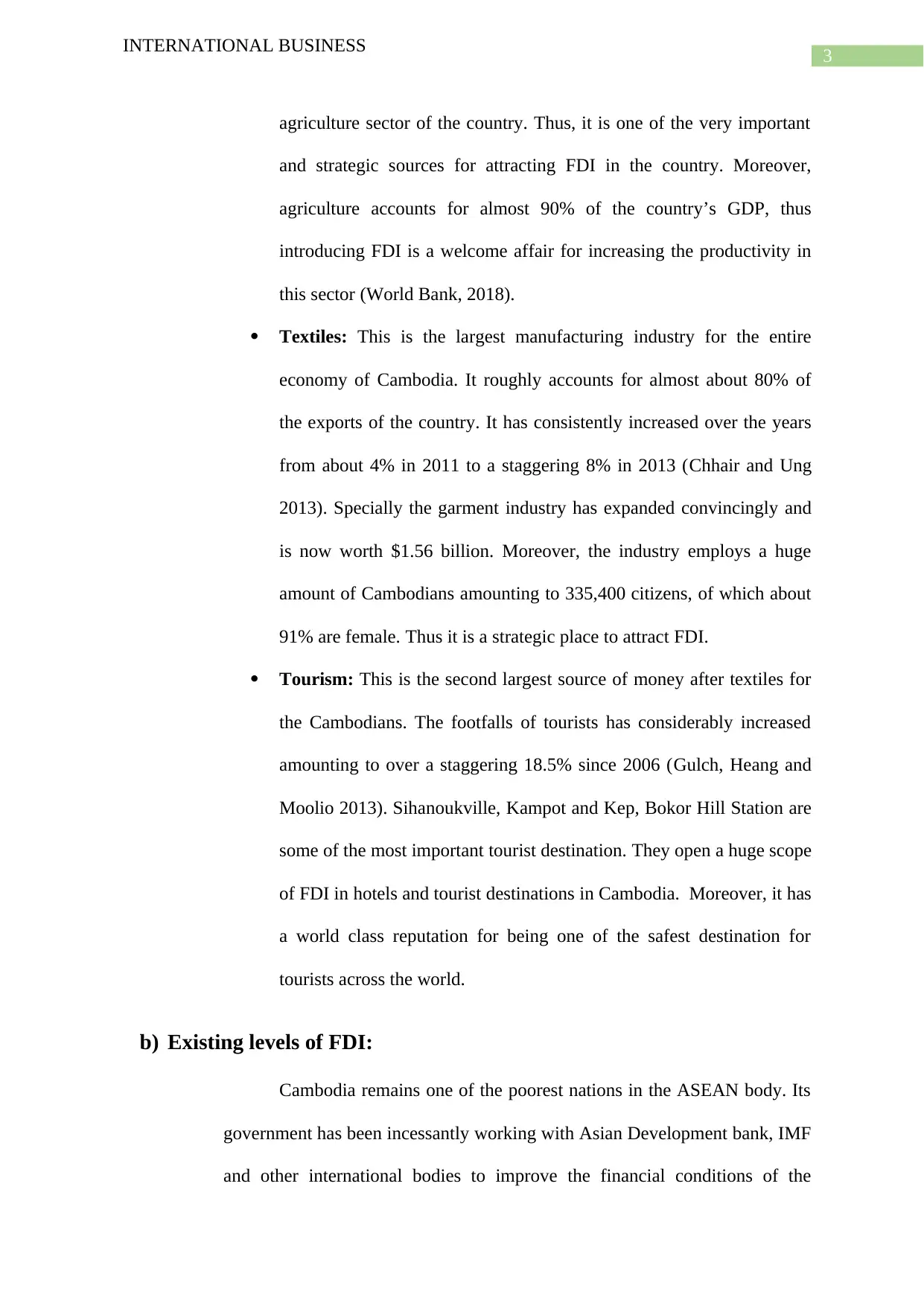
3
INTERNATIONAL BUSINESS
agriculture sector of the country. Thus, it is one of the very important
and strategic sources for attracting FDI in the country. Moreover,
agriculture accounts for almost 90% of the country’s GDP, thus
introducing FDI is a welcome affair for increasing the productivity in
this sector (World Bank, 2018).
Textiles: This is the largest manufacturing industry for the entire
economy of Cambodia. It roughly accounts for almost about 80% of
the exports of the country. It has consistently increased over the years
from about 4% in 2011 to a staggering 8% in 2013 (Chhair and Ung
2013). Specially the garment industry has expanded convincingly and
is now worth $1.56 billion. Moreover, the industry employs a huge
amount of Cambodians amounting to 335,400 citizens, of which about
91% are female. Thus it is a strategic place to attract FDI.
Tourism: This is the second largest source of money after textiles for
the Cambodians. The footfalls of tourists has considerably increased
amounting to over a staggering 18.5% since 2006 (Gulch, Heang and
Moolio 2013). Sihanoukville, Kampot and Kep, Bokor Hill Station are
some of the most important tourist destination. They open a huge scope
of FDI in hotels and tourist destinations in Cambodia. Moreover, it has
a world class reputation for being one of the safest destination for
tourists across the world.
b) Existing levels of FDI:
Cambodia remains one of the poorest nations in the ASEAN body. Its
government has been incessantly working with Asian Development bank, IMF
and other international bodies to improve the financial conditions of the
INTERNATIONAL BUSINESS
agriculture sector of the country. Thus, it is one of the very important
and strategic sources for attracting FDI in the country. Moreover,
agriculture accounts for almost 90% of the country’s GDP, thus
introducing FDI is a welcome affair for increasing the productivity in
this sector (World Bank, 2018).
Textiles: This is the largest manufacturing industry for the entire
economy of Cambodia. It roughly accounts for almost about 80% of
the exports of the country. It has consistently increased over the years
from about 4% in 2011 to a staggering 8% in 2013 (Chhair and Ung
2013). Specially the garment industry has expanded convincingly and
is now worth $1.56 billion. Moreover, the industry employs a huge
amount of Cambodians amounting to 335,400 citizens, of which about
91% are female. Thus it is a strategic place to attract FDI.
Tourism: This is the second largest source of money after textiles for
the Cambodians. The footfalls of tourists has considerably increased
amounting to over a staggering 18.5% since 2006 (Gulch, Heang and
Moolio 2013). Sihanoukville, Kampot and Kep, Bokor Hill Station are
some of the most important tourist destination. They open a huge scope
of FDI in hotels and tourist destinations in Cambodia. Moreover, it has
a world class reputation for being one of the safest destination for
tourists across the world.
b) Existing levels of FDI:
Cambodia remains one of the poorest nations in the ASEAN body. Its
government has been incessantly working with Asian Development bank, IMF
and other international bodies to improve the financial conditions of the
Paraphrase This Document
Need a fresh take? Get an instant paraphrase of this document with our AI Paraphraser
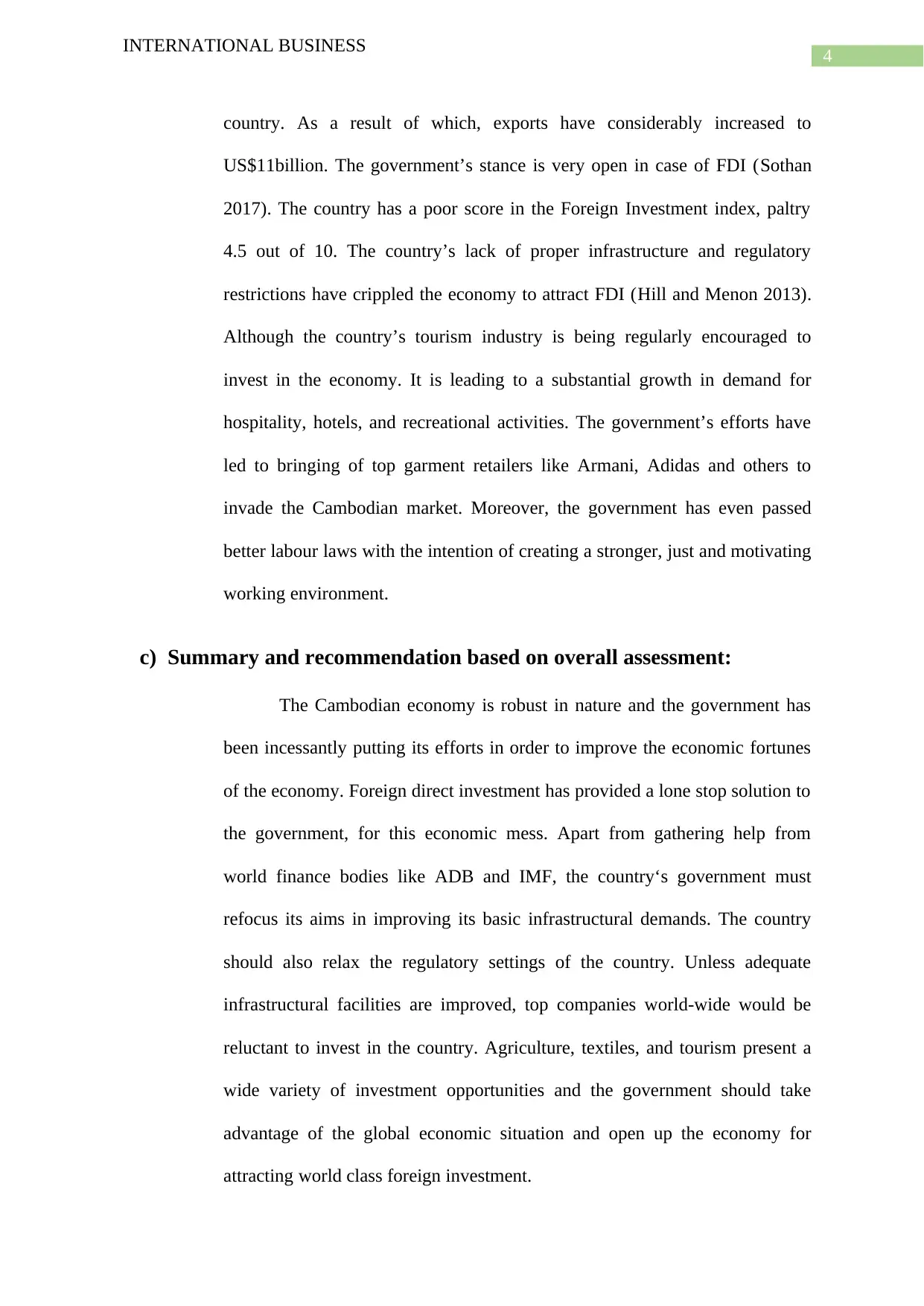
4
INTERNATIONAL BUSINESS
country. As a result of which, exports have considerably increased to
US$11billion. The government’s stance is very open in case of FDI (Sothan
2017). The country has a poor score in the Foreign Investment index, paltry
4.5 out of 10. The country’s lack of proper infrastructure and regulatory
restrictions have crippled the economy to attract FDI (Hill and Menon 2013).
Although the country’s tourism industry is being regularly encouraged to
invest in the economy. It is leading to a substantial growth in demand for
hospitality, hotels, and recreational activities. The government’s efforts have
led to bringing of top garment retailers like Armani, Adidas and others to
invade the Cambodian market. Moreover, the government has even passed
better labour laws with the intention of creating a stronger, just and motivating
working environment.
c) Summary and recommendation based on overall assessment:
The Cambodian economy is robust in nature and the government has
been incessantly putting its efforts in order to improve the economic fortunes
of the economy. Foreign direct investment has provided a lone stop solution to
the government, for this economic mess. Apart from gathering help from
world finance bodies like ADB and IMF, the country‘s government must
refocus its aims in improving its basic infrastructural demands. The country
should also relax the regulatory settings of the country. Unless adequate
infrastructural facilities are improved, top companies world-wide would be
reluctant to invest in the country. Agriculture, textiles, and tourism present a
wide variety of investment opportunities and the government should take
advantage of the global economic situation and open up the economy for
attracting world class foreign investment.
INTERNATIONAL BUSINESS
country. As a result of which, exports have considerably increased to
US$11billion. The government’s stance is very open in case of FDI (Sothan
2017). The country has a poor score in the Foreign Investment index, paltry
4.5 out of 10. The country’s lack of proper infrastructure and regulatory
restrictions have crippled the economy to attract FDI (Hill and Menon 2013).
Although the country’s tourism industry is being regularly encouraged to
invest in the economy. It is leading to a substantial growth in demand for
hospitality, hotels, and recreational activities. The government’s efforts have
led to bringing of top garment retailers like Armani, Adidas and others to
invade the Cambodian market. Moreover, the government has even passed
better labour laws with the intention of creating a stronger, just and motivating
working environment.
c) Summary and recommendation based on overall assessment:
The Cambodian economy is robust in nature and the government has
been incessantly putting its efforts in order to improve the economic fortunes
of the economy. Foreign direct investment has provided a lone stop solution to
the government, for this economic mess. Apart from gathering help from
world finance bodies like ADB and IMF, the country‘s government must
refocus its aims in improving its basic infrastructural demands. The country
should also relax the regulatory settings of the country. Unless adequate
infrastructural facilities are improved, top companies world-wide would be
reluctant to invest in the country. Agriculture, textiles, and tourism present a
wide variety of investment opportunities and the government should take
advantage of the global economic situation and open up the economy for
attracting world class foreign investment.

5
INTERNATIONAL BUSINESS
INTERNATIONAL BUSINESS
⊘ This is a preview!⊘
Do you want full access?
Subscribe today to unlock all pages.

Trusted by 1+ million students worldwide
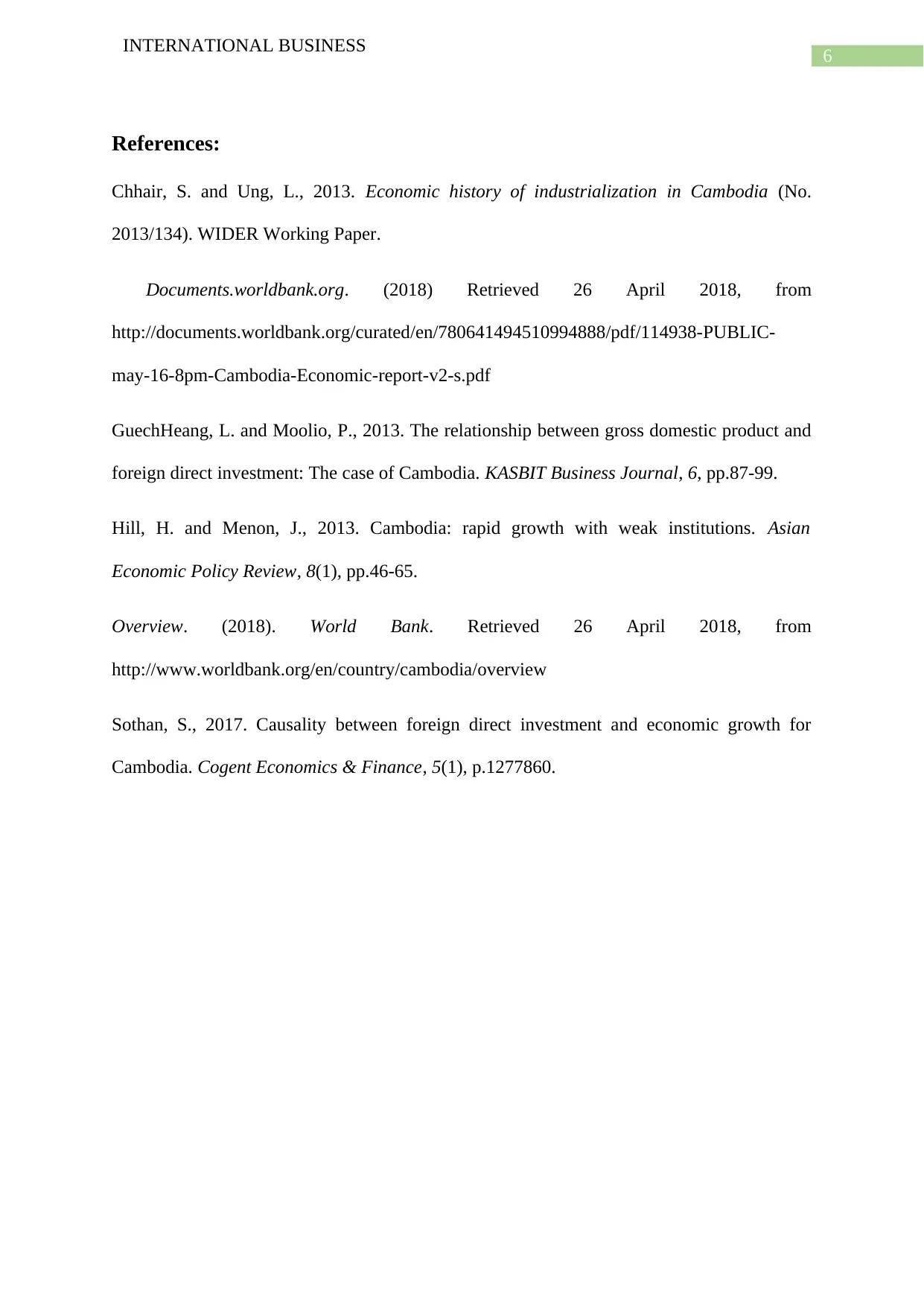
6
INTERNATIONAL BUSINESS
References:
Chhair, S. and Ung, L., 2013. Economic history of industrialization in Cambodia (No.
2013/134). WIDER Working Paper.
Documents.worldbank.org. (2018) Retrieved 26 April 2018, from
http://documents.worldbank.org/curated/en/780641494510994888/pdf/114938-PUBLIC-
may-16-8pm-Cambodia-Economic-report-v2-s.pdf
GuechHeang, L. and Moolio, P., 2013. The relationship between gross domestic product and
foreign direct investment: The case of Cambodia. KASBIT Business Journal, 6, pp.87-99.
Hill, H. and Menon, J., 2013. Cambodia: rapid growth with weak institutions. Asian
Economic Policy Review, 8(1), pp.46-65.
Overview. (2018). World Bank. Retrieved 26 April 2018, from
http://www.worldbank.org/en/country/cambodia/overview
Sothan, S., 2017. Causality between foreign direct investment and economic growth for
Cambodia. Cogent Economics & Finance, 5(1), p.1277860.
INTERNATIONAL BUSINESS
References:
Chhair, S. and Ung, L., 2013. Economic history of industrialization in Cambodia (No.
2013/134). WIDER Working Paper.
Documents.worldbank.org. (2018) Retrieved 26 April 2018, from
http://documents.worldbank.org/curated/en/780641494510994888/pdf/114938-PUBLIC-
may-16-8pm-Cambodia-Economic-report-v2-s.pdf
GuechHeang, L. and Moolio, P., 2013. The relationship between gross domestic product and
foreign direct investment: The case of Cambodia. KASBIT Business Journal, 6, pp.87-99.
Hill, H. and Menon, J., 2013. Cambodia: rapid growth with weak institutions. Asian
Economic Policy Review, 8(1), pp.46-65.
Overview. (2018). World Bank. Retrieved 26 April 2018, from
http://www.worldbank.org/en/country/cambodia/overview
Sothan, S., 2017. Causality between foreign direct investment and economic growth for
Cambodia. Cogent Economics & Finance, 5(1), p.1277860.
1 out of 7
Related Documents
Your All-in-One AI-Powered Toolkit for Academic Success.
+13062052269
info@desklib.com
Available 24*7 on WhatsApp / Email
![[object Object]](/_next/static/media/star-bottom.7253800d.svg)
Unlock your academic potential
Copyright © 2020–2025 A2Z Services. All Rights Reserved. Developed and managed by ZUCOL.




